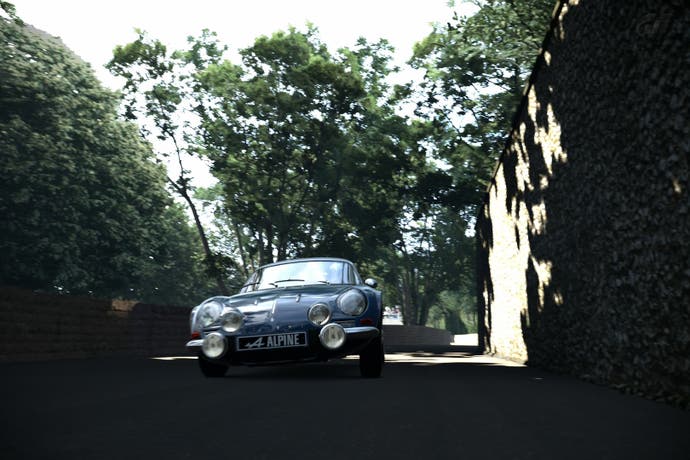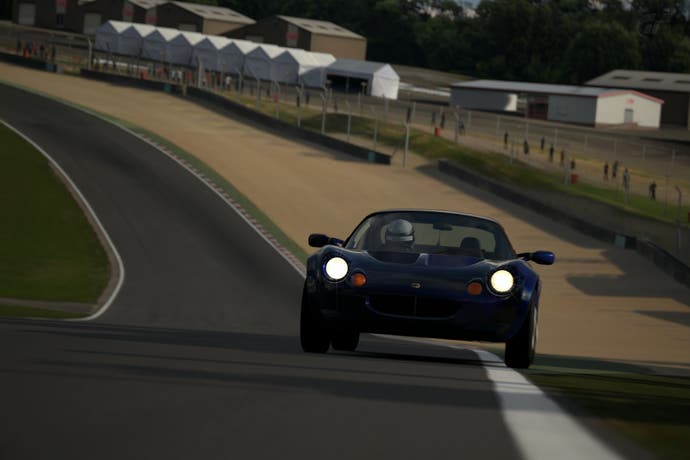Gran Turismo 6 review
Unfinished symphony.
It's not finished. Even after a day one patch that brings in multiplayer, seasonal events and new special events, Gran Turismo 6 is far from complete. Even taking into consideration the course maker and associated GPS data logging that's due in the coming months or - and take this one with a pinch of salt - the improved sound effects that Polyphony Digital plans to patch in, it likely won't ever feel like the final article.
For now, and for the foreseeable future of Gran Turismo 6, angry collisions are met with a thud more fitting of a gentle disagreement between two row-boats on the Serpentine, while mobs of throbbing GT3 engines sound like a swarm of wheezing hoovers. Damage has been pared back from its already slim implementation in Gran Turismo 5 - a 180mph impact met with a visual effect that looks no more severe than the aftermath of someone spilling a pint of milk over your car - and in offline races there's no longer a mechanical effect on the handling at all.
There's no livery editor, and while there's now slightly more in the way of augmentations you can strap on to your car, most improvements are kept under the bonnet, and under the skin. And still, nearly three years after they became an extra in racing games that was no longer optional, there's not much by way of a mode built around custom, dynamic online leaderboards.

But there is so much more besides. Gran Turismo 6 is a vast, sprawling compendium of cars, a hysterical hymn to the experience of driving and a well-worn, slightly dog-eared encyclopedia of the automotive world. It is, at times, simply overwhelming in its breadth.
Like when, in the space of one short hour, you're kicked from a run up Goodwood's hill climb behind the sumptuous leather steering wheel of a Renault Alpine A110 to a kart race that nimbly winds around Silverstone's infield, and then on to the surface of the moon where you crest St. George's crater and head towards Hadley Rille in a fittingly floaty lunar rover.
You can drive on the moon. Gran Turismo has never been short of eccentricities, but a problem prior to Gran Turismo 6 is how readily they were ferreted away, presenting at face value a game that appeared, unfairly, clinical and soulless. That's not so much of a problem this time. The single-player progression, for the first time in the series' recent history, plots a meaningful, varied course through the wealth of content, offering up countless distractions and diversions to complement the core grind.
The foundations are familiar enough, with a straggle of events spread across several slowly unlocking tiers. Stars are awarded for success - it's nice to see something appropriate lifted from mobile game design, for once - and collecting them helps open up new championships, and new tiers. Licence tests are back at the heart of Gran Turismo, too, offering the final obstacle before you can progress to a new rank - but they're gentler, less fussy challenges now.
It's what lies on the periphery that really shifts things up, though. Coffee Break challenges are small, throwaway novelty events - hurl an X-Bow at a gaggle of cones, or see how long you can make a couple of litres of fuel last around the Nordschleife - but there's more substance elsewhere. Mission Races loan you a car and set you out in pursuit of a perfect delta, while special events let you recreate the Apollo 15 mission or grant you access to Gran Turismo 6's headlining cars for a short, exhilarating spurt through the Earl of March's grounds at Goodwood House.

From West Sussex to the Moon, and seemingly everywhere in-between. Gran Turismo 6's tracklist is staggering in its scope, and quite possibly the most complete ever seen in a driving game. There are headline additions like Bathurst and Brands Hatch, alongside surprise treats like little-known private circuit Ascari, an endlessly varied, technical course that runs through the mountain range of Ronda.
It's Brands Hatch that's the star for me, and not just because it's the one track featured I know intimately in real life. The slopes and inclines of the narrow circuit are the perfect showcase for Gran Turismo 6's new handling model; at the foot of Paddock Hill Bend you can feel the suspension load and compress before you make the ascent to Druids hairpin, and the downhill run to Graham Hill Bend provides a master-class in how to settle an unhappy car. Out into the Kent woods, the crests and cambers of Hawthorn, Westfield and Dingle Dell - a trilogy of right-handers that are best approached as one clean swoop - inspire balletic efforts conducted through springs, dampers and deft pedal-work. It's exquisite stuff.
The communication of weight, and of weight transfer, is where Gran Turismo 6 excels - and impressively, it's something felt in all of the 1200 plus cars on offer. In a Nissan GT-R you'll feel it under braking; quickly slowing its not insignificant weight while under lateral load is an act of busy hands and high hopes. In a softly sprung Lotus Europa, the weight can be shifted around as if you're a cat with a ball of string, gently pawing it this way and that.
That such a model is available via so many permutations - whether you want to take the infamous RUF Yellow Bird around the 'Ring, or just hop in the Deltawing for a dawn drive down the Mulsanne - makes Gran Turismo 6 a comprehensive, exhilarating prospect for those with even the merest trace of petrol running through their veins.
Playing through a good wheel - and a fair number are supported, with Fanatecs, Logitechs and Thrustmasters all applying themselves well in our experience - places Polyphony's handling model on a par with more serious-minded PC sims such as iRacing and rFactor. On a pad, it's not quite the same story - the DualShock 3 acquits itself well enough in one of its last high profile outings, but it'll never be the measure of what Turn 10's achieved with the Xbox One's handsome new controller.
A more significant achievement is that Polyphony's engine is quite often the measure of what we're seeing on next-gen consoles. Gran Turismo's attention to detail is legendary, but it's the light the studio's craft is cast in where Gran Turismo 6 shines. Seeing the thin light cast by a car illuminating the forests of the Nurburgring in the late afternoon sun creates an eerily life-like scene, and one that's not without its own beauty: it might not be as striking as the cinematic fantasies delivered up by the likes of Naughty Dog, but it's just as impressive in what it ekes out of Sony's ageing console. As a swansong for the PlayStation 3, it's an appropriately attractive tribute to the power of the departing system.
It's also, somewhat fittingly given the console's patchy past, troubled. The quality's not consistent, and even if the fidelity of some of the standard cars - whose heritage stretches back to the time of Gran Turismo 4 - has been improved, there are still just as many times you think you're playing a PlayStation 2 game as there are ones when you might be tricked into thinking this could be running on a PlayStation 4.

Gran Turismo 6 is next-gen in other ways, too, with the spectre of microtransactions lingering near. Polyphony's at least been wise to partition them away from the game - if you weren't aware of their inclusion beforehand, you wouldn't know they're there at all. The economy is, to all intents and purposes, identical to Gran Turismo 5's - prize cars aren't handed out quite so generously, but payouts are on a similar scale while car prices likewise remain frozen.
That's not to say it isn't a problem, though. Gran Turismo 5's economy was broken, an issue belatedly acknowledged by Polyphony in the implementation of seasonal events with bloated payouts that soon became the place to grind out credits. Seasonals are back, though right now the payouts are paltry in comparison to their predecessors, meaning the grind that faces players just before they unlock Gran Turismo 6's final tier is daunting. There was an opportunity to redress the balance this time out. By offering a fast track to progression through microtransactions, the problem is once again acknowledged, although the solution right now is far from savoury.
Gran Turismo 6 is broken and brilliant all at once, then, which seems destined to always be this series' way. It lends it a certain charm, though: if Forza, with its impeccable sheen and its flair for dramatics, sets out to mimic the world of Top Gear and Jeremy Clarkson, then Gran Turismo feels more like Denis Jenkinson, MotorSport's beloved correspondent who slept with a Rolls Royce engine at the foot of his bed in a rotting Hampshire cottage. It's all wide-eyed enthusiasm, erratically delivered through a scruffy egg-flecked beard. I know which one I'd rather spend a Sunday afternoon with.
And so, 15 years since its inception, Gran Turismo carries on its pursuit much as it always has, delivering a driving simulator that's as exhausting as it is exhaustive, as infuriating as it is intoxicating. As a foundation, it's certainly more stable than its predecessor - and as a way to explore the thrill of four wheels it is, despite its many faults, exceptional, brilliant and pretty much peerless. It's not finished yet, but Polyphony likely never will be - and in Gran Turismo 6 it's just delivered the broadest, most complete iteration of its epic vision.


